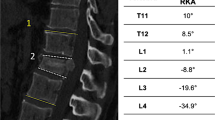Abstract
Aim of study
A prospective study to evaluate the results of monosegmental fixation; fixation of the fractured level with the adjacent vertebra sharing the same disc, in selected types of lumbar and thoracic fractures. This technique aims at saving motion levels by fusion of the only affected motion segment without sacrificing other levels.
Methods
Forty patients enrolled in this study between August 2011 and October 2013. The inclusion criteria were recent thoracic or lumbar vertebral fractures (less than 2 weeks). The fracture involves only one of the end plates of the vertebrae (either the superior or the inferior). The other end plate and both pedicles should be intact. The exclusion criteria were cervical fractures, fractures that include both end plates or pedicles of the vertebra, fracture dislocation, and load sharing classification score more than seven. All patients underwent monosegmental fixation with pedicle screw fixation. Eight patients were supplemented with interbody grafts. Radiological evaluation was done to assess local kyphosis angle, degree of compression of the anterior column, the degree of comminution, retropulsed fragment, neural canal compromise, integrity of the affected end plate, exclusion of pedicle fracture, and most important to assure that only one end plate is affected. All patients were assessed neurologically according to Frankel grading system. Patient were assessed by Denis pain scale and Denis work scale.
Results
The age of the patients was of a mean of 34.5 years old. All patients were Frankle E at time of presentation and remained the same post-operative. The mean operative time from incision time to end of skin closure was 74.2 min. The mean blood loss was 230 ml. The pre-operative degree of local kyphosis; was of a mean 8.22°. This was improved to 2.25° at the immediate postoperative x-rays. At two years follow up, the loss of correction was of a mean 0.85° which was insignificant. The pre-operative percentage of height lost improved from a mean of 56.05 % to post-operative mean of 90.125 %. At the end of follow up, no pseudoarthrosis cases or metal failure were noticed.
Discussion
Thoracic and lumbar fractures are common in young adults. Surgical treatment offers early rehabilitation and preserves spine alignment. Monosegmental fixation technique in selected types of dorsal and lumbar fractures offers spine stability and preserves motion segments. It fuses only one motion segment that is prone for later instability or deformity. Reconstrcution of the anterior column can be achieved through TLIF approach in combination of monosegmental fixation to achieve 360° fusion.
Conclusion
Monosegmental fixation is an effective technique. It can save motion segments in young patients with adequate spine stability and good functional outcomes.



Similar content being viewed by others
References
Kim B-G, Dan J-M, Shin D-E (2015) Treatment of thoracolumbar fracture. Asian Spine J 9(1):133–146. doi:10.4184/asj.2015.9.1.133
Dai LY, Jiang LS, Jiang SD (2008) Conservative treatment of thoracolumbar burst fractures: a long-term follow-up results with special reference to the load sharing classification. Spine (Phila Pa 1976) 33:2536–2544
Shin TS, Kim HW, Park KS, Kim JM, Jung CK (2007) Short-segment pedicle instrumentation of thoracolumbar burst-compression fractures: short term follow-up results. J Korean Neurosurg Soc 42:265–270
Singh R, Rohilla RK, Kamboj K, Magu NK, Kaur K (2014) Outcome of pedicle screw fixation and monosegmental fusion in patients with fresh thoracolumbar fractures. Asian Spine J 8(3):298–308. doi:10.4184/asj.2014.8.3.298,
Denis F (1983) The three column spine and its significance in the classification of acute thoracolumbar spinal injuries. Spine (Phila Pa 1976) 8(8):817–31
Reinhold M, Audigé L, Schnake KJ, Bellabarba C, Dai L-Y, Oner FC (2013) AO spine injury classification system: a revision proposal for the thoracic and lumbar spine. Eur Spine J 22(10):2184–2201. doi:10.1007/s00586-013-2738-0
McCormack T, Karaikovic E, Gaines RW (1994) The load sharing classification of spine fractures. Spine 19(15):1741–1744
Denis F, Armstrong GW, Searls K, Matta L (1984) Acute thoracolumbar burst fractures in the absence of neurologic deficit. A comparison between operative and nonoperative treatment. Clin Orthop Relat Res 189:142–149
Liu S, Li H, Liang C et al (2009) Monosegmental transpedicular fixation for selected patients with thoracolumbar burst fractures. J Spinal Disord Tech 22:38–44
Dickson JH, Harrington PR, Erwin WD (1978) Results of reduction and stabilization of the severely fractured thoracic and lumbar spine. J Bone Joint Surg 60A:799–805
Jacobs RR, Casey MP (1984) Surgical management of thoracolumbar spinal injuries. Clin Orthop Relat Res 189:22–35
Shin T-S, Kim H-W, Park K-S, Kim J-M, Jung C-K (2007) Short-segment pedicle instrumentation of thoracolumbar burst-compression fractures; short term follow-up results. J Korean Neurosurg Soc 42(4):265–270. doi:10.3340/jkns.2007.42.4.265
Cumhur OF, Robert R, Van DR, Lino MP, Wouter JA, Abraham JV (1998) Changes in the disc space after fractures of the thoracolumbar spine. JBJS Br 80b(5):833–839
Epstein NE (2015) Adjacent level disease following lumbar spine surgery: a review. Surg Neurol Int 6(Suppl 24):S591–S599. doi:10.4103/2152-7806.170432
Wang X–Y, Dai L-Y, Xu H-Z, Chi Y-L (2008) Kyphosis recurrence after posterior short segment fixation in thoracolumbar burst fractures. J Neurosurg 8(3):246–254. doi:10.3171/SPI/2008/8/3/246
Schmid R, Krappinger D, Blauth M, Kathrein A (2011) Mid-term results of PLIF/TLIF in trauma. Eur Spine J 20:395–402
Schmid R, Krappinger D, Seykora P, Blauth M, Kathrein A (2010) PLIF in thoracolumbar trauma: technique and radiological results. Eur Spine J 19:1079–1086
Author information
Authors and Affiliations
Corresponding author
Rights and permissions
About this article
Cite this article
Ibrahim, F.M.F., Abd EL-rady, A.ER.M. Mono segmental fixation of selected types of thoracic and lumbar fractures; a prospective study. International Orthopaedics (SICOT) 40, 1083–1089 (2016). https://doi.org/10.1007/s00264-016-3152-0
Received:
Accepted:
Published:
Issue Date:
DOI: https://doi.org/10.1007/s00264-016-3152-0




